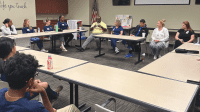The Clinical Nurse Leader (CNL) credential is so new that many people don’t know what it is. The CNL role emerged, after several years of research and discussion, as a way to allow master’s-prepared nurses to stay at the patient’s side to oversee and manage care delivery. Created by the American Association of Colleges of Nursing (AACN), the role was designed in collaboration with representatives from a wide range of healthcare leadership and expertise.
What CNLs do
CNLs communicate, plan, and implement care directly with other clinicians, including clinical nurse specialists (CNSs), nurse practitioners, physicians, pharmacists, and social workers. Neither administrators nor managers, we oversee lateral integration of care for a distinct group of patients. In complex situations, we may actively provide direct patient care.
CNLs are accountable for healthcare outcomes for a specific group of patients within a unit or other setting. We assimilate and apply research-based information to develop, implement, and evaluate plans of care, thus ensuring that patients benefit from the latest healthcare innovations. As clinical decision makers and care managers, we coordinate the direct care activities of other nursing staff and healthcare professionals. We also gather and evaluate patient outcomes and have the authority to change plans of care, when necessary.
The CNS role complements the advanced practice nurse (APN) role. For instance, a CNL may consult with a CNS when a specialized area of concern arises.
Educational preparation
To become a CNL, you’ll need to attend a master’s program that meets AACN requirements. (Unlike an APN, the CNL candidate doesn’t receive specialist education in a defined practice area.) After graduation, you’ll need to pass a national certification exam to use the title of CNL.
A day in my life as a CNL
The CNL role is implemented variably from one setting to the next. I’ll use my own job activities to illustrate how some facilities implement it.
I work in a 24-bed medical unit at Wolfson Children’s Hospital in Jacksonville, Florida, which implemented the CNL role in January 2006. At this 180-bed pediatric hospital, which partners with a large academic institution, the CNL is considered lateral to the nurse manager and has 24-hour accountability for all clinical care provided on the unit.
I spend most of my time on the unit with nurses and patients, but don’t take a direct patient assignment or handle management issues. My work complements that of the CNS who serves this unit. My sole focus is the unit, whereas the CNS focuses on several units. I act as the bedside resource, whereas the CNS designs formal educational programs for staff. I’m closely involved with patients on the unit; the CNS is available to consult when needed.
Each day, I briefly review medical records for all patients on the unit. This gives me a chance to assess each patient’s plan of care for the upcoming shift and to plan for the patient’s entire hospital experience. From this review, I identify the day’s “hot spots,” such as patient discharge needs, procedures, or plan-of-care clarification.
Next, I collaborate with each staff nurse on the unit, quickly reviewing concerns for each patient as well as daily discharge planning. After assessing data from the chart reviews and nursing staff, I participate in physician rounds.
I assess the most critically ill patients, participate in family education, and go on daily rounds with each patient and family. During these rounds, I review the plan of care with the family. Frequently, the family has questions about their child’s condition, which I can address or arrange for members of other disciplines to address.
Integrating care laterally
Integrating the plan of care laterally with other disciplines is a key component of my role. I present the concerns of multiple disciplines as well as those of the patient and family (if needed) to the discipline that needs to take action. For example, nursing concerns about feeding issues can be addressed with the speech therapy and nutrition departments, whose recommendations can be taken to the physician.
Recently, a child on my unit needed a magnetic resonance imaging (MRI) scan with sedation. She was living with her grandmother while her mother was out of state. To ensure that consent was obtained rapidly so the procedure wouldn’t be delayed, I coordinated with the social work, MRI, and anesthesia departments as well as the child’s mother. My actions allowed the bedside nurse to spend more time with patients.
Navigator, patient advocate, and problem solver
As an expert clinical resource for the unit, I help staff nurses navigate the complex hospital system. I help staff nurses identify potential patient problems, including deteriorating physical conditions that need immediate attention. In one case, a child returned from surgery with a chest tube. The nurse had no experience caring for a child with a chest tube—but I was available to help her assess the patient and teach her about patient care.
Seeing the big picture
Beyond my daily unit responsibilities, I assess the “big picture,” initiating changes when necessary and identifying areas where staff members need additional education. My CNL preparation enables me to evaluate and change system processes that don’t function as they should. Where staff nurses look for ways to solve immediate problems, I seek a solution to solve the problems for all similar patients by repairing the process.
I also review unit policies to ensure they’re based on best practice and evidence, and have updated or developed multiple policies. For instance, I developed an oral hydration maintenance protocol for nurses and have worked closely with physicians to create an order set based on evidence for bronchiolitis. I also created a quick-reference notebook for nursing care of patients with complex respiratory problems. The notebook includes policies, up-to-date reference articles, and “to do” lists for patient admission, each shift, and during transport. Using these lists has relieved staff anxiety over meeting patient care needs. For more formal education needs, I refer staff to the CNS.
Challenges of the CNL role
One of the most challenging things about being a CNL is defining my role within the organization—and standing firm. CNLs have diverse and valuable skills that can be applied in many areas away from the unit. They must commit to staying on the unit, helping nurses and patients, for the vast majority of their time.
Positive staff response
At Wolfson, response to the CNL role has been positive. Physicians are enthusiastic about the input I provide during rounds. I’ve gotten positive feedback from other professionals, too, because my actions allow them to get involved in care earlier during patients’ hospital stays.
Overwhelmingly, staff nurses on my unit support the CNL role. I provide consistency to care in a unit where most nurses work 12-hour shifts. I fill in gaps for them, stay available on the unit for support and answers, and handle complex patient issues. The CNL role has been well integrated into this pediatric acute-care setting, and is being implemented on three other hospital units.
Selected references
American Association of Colleges of Nursing. Tool Kit for the Implementation of the Clinical Nurse Leader Guide for Practice and Academic Partners. May 2006. www.aacn.nche.edu/CNL/toolkit.htm. Accessed April 29, 2008.
American Association of Colleges of Nursing. White Paper on the Education and Role of the Clinical Nurse Leader. February 2007. www.aacn.nche.edu/Publications/WhitePapers/CNL2-07.pdf. Accessed April 29, 2008.
Bowcutt M, Goolsby M. The Clinical Nurse Leader: promoting patient centered outcomes. Nurs Adm Q. 2006;30:156-151.
Wiggins MS. The partnership care delivery model. J Nurs Adm. 2006;
36:334-335.
Amanda B. Brown is a Clinical Nurse Leader on the Pediatric Medical Unit at Wolfson Children’s Hospital in Jacksonville, Fla.


















1 Comment.
what code of ethics does a CNL use to guide their practice